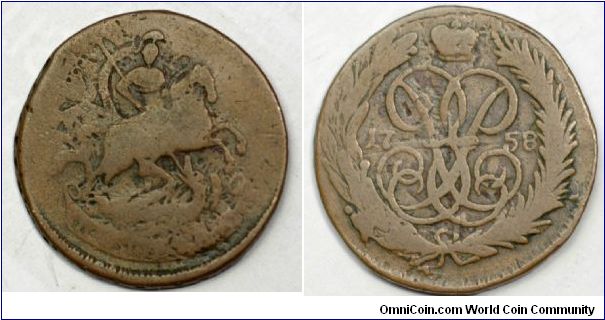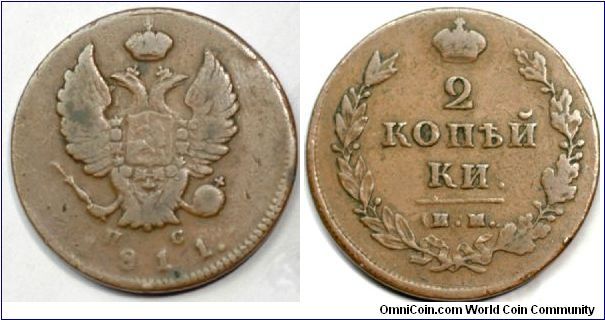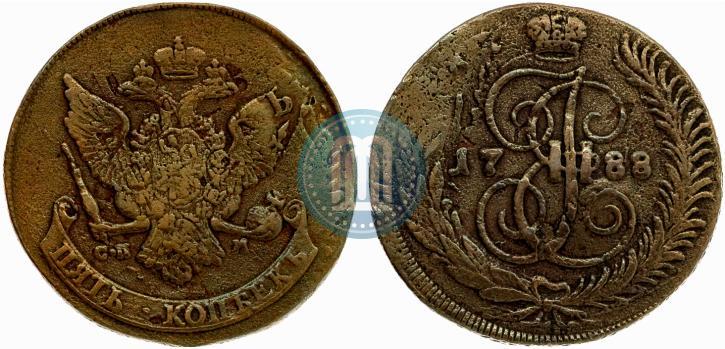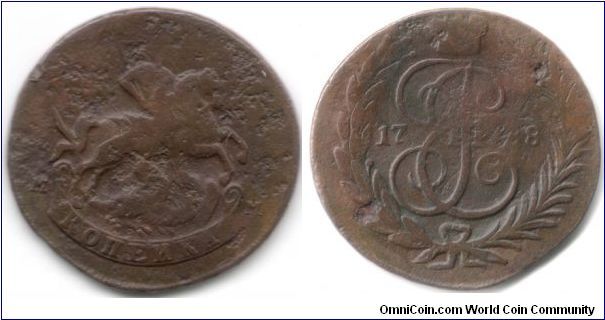-
Posts
1,321 -
Joined
-
Last visited
Content Type
Profiles
Forums
Gallery
Events
Articles
Posts posted by squirrel
-
-
yes please.
would like!

-
impressive restoration!
-
Beautiful work, Gx! Well worth the effort.
A very nice specialty collection, and nicely photographed!
Thank you for showing!
-
http://www.staraya-moneta.ru/forum/messages/forum7/topic19591/message167218/#message167281
Those who can read Russian will have some fun in spare time.
google translate does a good job of it, although not perfect, an entertaining read.
-
I like those kopecks on Swedish copper
I found this one on ebay a long time ago.......

-
Yes, Eugene and Igor, that was my coin.
I'll better start a new topic on "the 1726 kopek", it is quite a story, I think I might still have a letter of the late V.V. Uzdennikov somewhere. All this was 25-30 years ago.
Give me a few days
 .
.Sigi
 Perhaps you could incorporate that story as a preface to your someday (I can dream, cant I?) definitive reference book on the large copper coinage of the Russian Empire, 1758-1810, with color glossy plates, of course.
Perhaps you could incorporate that story as a preface to your someday (I can dream, cant I?) definitive reference book on the large copper coinage of the Russian Empire, 1758-1810, with color glossy plates, of course.You certainly have done the research!

-
lots of variety during that year... IM over CPB

-
I thought that looked familiar! This coin is in my collection... From Markov, some years ago.

-
-
Certainly an interesting composition. Is Dr Freud taking new patients?

-
It is not radical, does not harm the metal but removes anything else. Including the small impurities included in the surface.
ammonia will do the same thing.
If a surface is worn smooth as during normal circulation, any porous areas fill flush with patina/ dirt/ oil / etc and are incorporated into the "skin" of a coins surface. anything that remove oxidation, will clean out these pores, and leave a rought texture that will never retone. verdigris eats copper, so when the verdigris is removed, obviously the eaten away copper surface is no longer smooth, relative the the rest of coin.
-
The first part of the auction, sold in October 2012, realized a hammer price of about $14,117,550 U.S. The second part of the Sincona Collection (sold in October 2013) realized a total hammer price of 10.89 million Swiss francs (about $11,945,200 U.S.). Though the collection was originally slated to be sold in just three parts, a fourth auction is now scheduled for 2015.
from the coinworld article linked above.
-
thank you for re-linking me to the TM thread, Eugene. I must have missed it when it was active. Very educational for me. Especially the history of the mint there.
I do have a lonely 1787 TM 5k, and its metal quality is less than wonderful, to be sure,and quite a dark patina, typical of impurities in the copper , such as commonly seen in Siberian coinage. Although I recall the Siberian mined copper included silver and gold in small amounts, which could not be well separated out at the time. Have you seen any analysis of TM copper discussed on the Russian language coin forums?
-
i think perhaps he has been playing with the mass spectrometer at work again...?

(i suspect with "cell" in your screen name you are a scientist?)
-
Good example, Ex!
Artists who work in metal sculpture have for hundreds of years developed techniques to artificially patinate metals. Bronze, copper, Brass, silver.... all can be made to look "old". The techniques and recipes us heat, flames, and a whole college chemistry class worth of various acids, salts, and other assorted ingredients. There is a LOT of trial and error, and patience. It is a skill/hobby unto itself. How much time do you want to spend ?
I work in Architecture. Verdigris on copper is a desirable look. I have seen some go to great lengths to make a brand new shiny copper roof on a historic building look old. The main ingredient of the old timers recipe? Yup. Horse piss.

-
-
Hi Sigi. I have coins with verdegris, that once restored as best as I could with much trial and error, and after years of aging to regain some modest patina, have this same look. The dark areas have much to do with the microscopic texture of the areas that were corroded. They will not color the same as the smooth fields and struck detail, smoothed somewhat from circulation. Still a very nice coin! Leave it be!
(ps can you find any Elizabeth 5K under there somewhere?)
-
I respectfully think you have answered your own question. But do not discount the collector who is satisfied with an area of past interest in their collection, and ready to fund a new area of interest by selling.
-
So I think. I want sell it)
this is not a question.
-
could be copper paint.
-
can not advise you on max bid... but please post result when sold, as I am curious as well, as an indication of todays market conditions for ugly but rare copper.
good luck if you go after it!
-
very nice!
The undercoin is very hard to spot on these...
My 1788MM 1k / 1762 2K says hello..

-
This mini-variant appears only with 1758 date (and the Sestrorezk mint contributed only to that date).
Did you find any in that shoebox?

No '58s at all...

But this gives me something to chase, now, doesnt it!
FWIW I do have 59MM, 60MM, 61, 62. Also missing the elusive 61MM

-
Is this only for 1758, or the later years as well?
Nice find, Sigi! Im off to check my shoebox for a '58 and have a look!


Sincona 19 (The SINCONA Collection - Part 3)
in Russian Coin Forums
Posted
I love the wonderful, detailed description and background story on the auction page.